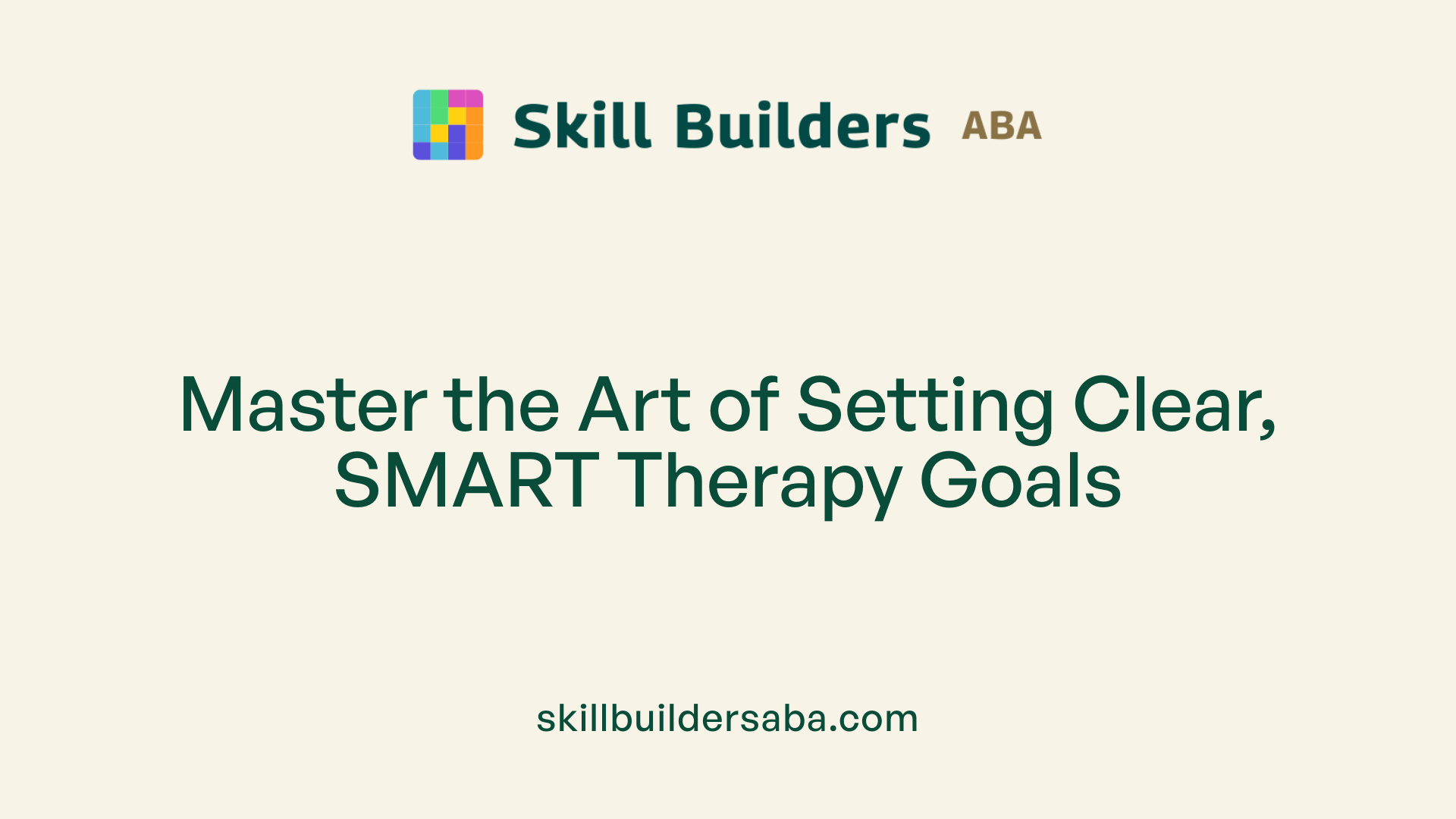How to set realistic therapy goals
Effective Strategies for Achieving Therapy Success

Understanding the Importance of Goal Setting in Therapy
Setting well-defined, realistic therapy goals is cornerstone to effective psychotherapy. Goals provide direction, foster motivation, and create measurable milestones that mark progress. Through collaborative efforts between clients and therapists, clear goals help streamline the treatment process, making it more focused and responsive to the individual’s evolving needs.
The Benefits of Clear Goal Setting in Therapy
What are the benefits of goal setting in therapy?
Establishing clear goals in therapy provides numerous advantages for clients and therapists alike. First, it offers a well-defined direction and focus, helping clients understand exactly what they aim to achieve, whether it’s reducing anxiety, improving relationships, or developing healthier coping strategies. This clarity makes every session more purposeful and aligned with the client’s needs.
Additionally, goal setting boosts motivation and engagement. When clients see tangible milestones and progress markers, they feel more committed to the process. Achieving small steps increases self-confidence and encourages continued effort.
A strong therapeutic alliance is fostered through collaborative goal setting. When clients participate actively in defining their goals, they tend to feel more understood and supported, which strengthens trust with their therapist. This shared understanding increases treatment adherence and satisfaction.
Clear goals also reduce feelings of uncertainty and helplessness. Knowing what to work toward helps clients feel more in control of their recovery journey. Regular evaluation of these goals allows for adjustments, ensuring that therapy remains relevant and responsive to changing circumstances.
Finally, goal setting promotes empowerment and active participation. Clients become active agents in shaping their future, gaining confidence in their ability to effect change. Overall, establishing well-defined, achievable goals makes therapy more effective, satisfying, and goal-oriented.
Strategies for Effective Therapy Goal Setting
Clarify hopes and motives
The first step in effective therapy goal setting involves understanding what you hope to achieve through therapy. This might include overcoming anxiety, improving relationships, or gaining better emotional regulation. Reflecting on your hopes can be aided by tools like the Therapy Goals worksheet, which encourages you to articulate your desires clearly. Being honest about your motives helps set meaningful, personalized goals.
Collaborate with therapist
A crucial element is working together with your therapist to establish goals. Collaboration ensures your objectives are realistic and aligned with your values. During initial sessions, openly discuss your challenges, strengths, and future aspirations. This partnership fosters mutual understanding, builds trust, and increases motivation.
Use tools like worksheets and visualization
Structured tools such as goal exploration worksheets or visualization exercises help you clarify and commit to your goals. These resources guide you in imagining desired outcomes, breaking down complex issues, and creating actionable plans. Visualization in particular can boost motivation by helping you see tangible progress.
Develop specific, SMART goals
Effective goals should be concrete and well-defined. The SMART framework—Specific, Measurable, Attainable, Relevant, and Time-bound—ensures clarity and practicality. For example, instead of vague aims like "feel better," a SMART goal would specify, "practice mindfulness for 10 minutes daily over the next month to reduce stress." This clarity helps track progress and maintain focus.
Break goals into manageable steps
Large goals can feel overwhelming, so dividing them into smaller, manageable tasks is advisable. This approach reduces stress, increases motivation, and allows you to celebrate small victories along the way. For instance, if your goal is to improve communication skills, smaller steps could include practicing active listening or initiating conversations weekly.
Prioritize goals based on importance and resources
Focus on a few priority goals rather than attempting too many at once. Evaluate which goals are most urgent or impactful, considering your current resources and circumstances. This prioritization helps maintain focus and provides a clear roadmap for progress.
Incorporate flexibility for adjustments
As therapy progresses, your needs and challenges may change. Regularly reviewing your goals allows flexibility to modify or replace objectives. This ensures goals remain relevant, attainable, and aligned with your evolving aspirations.
Monitor progress regularly
Tracking your progress is essential for motivation and course correction. Use journals, checklists, or apps to record achievements and setbacks. Regular review sessions with your therapist can reinforce motivation, validate efforts, and ensure your objectives stay on track.
Implementing these strategies creates a structured yet adaptable approach to setting therapy goals. This process not only clarifies your desired outcomes but also fuels your commitment to growth and change.
Examples of Realistic and Achievable Therapy Goals

What are some examples of realistic therapy goals?
Effective therapy goals are practical and tailored to each person’s unique situation. They should conform to the SMART framework, meaning they are specific, measurable, achievable, relevant, and time-bound.
For instance, a person might aim to reduce their anxiety by learning and practicing mindfulness techniques for at least 10 minutes daily over the next month. This goal is clear and manageable, with a specific activity and a set timeframe.
Other examples include improving sleep quality within six weeks, increasing assertiveness by using new communication strategies in meetings over the next two months, or developing coping skills to handle stress better during busy periods.
When setting goals, it’s important to consider individual resources, such as time, support systems, and motivation. Goals that are realistic and aligned with current circumstances encourage steady progress and prevent frustration.
By focusing on these practical, well-structured goals, clients can stay motivated and confident as they work towards meaningful improvements.
Align with SMART criteria
To stay effective, goals should clearly specify what the client intends to achieve (Specific), how progress will be tracked (Measurable), whether it is feasible given their resources (Achievable), relevant to their broader well-being (Relevant), and have a clear deadline (Time-bound).
Examples of therapy goals include:
| Goal Type | Example | Details |
|---|---|---|
| Symptom reduction | Lower depression symptoms within 8 weeks | Use assessments and self-reports to monitor progress |
| Skill development | Learn relaxation techniques to manage anxiety | Practice daily and track frequency |
| Emotional regulation | Respond to emotional triggers more calmly | Focus on specific situations to improve |
| Behavior change | Reduce harmful behaviors over 3 months | Set small weekly targets |
| Relationship improvement | Improve communication with partner over 2 months | Use specific communication strategies |
Prioritize resources and motivation
Effective goal setting also takes into account the client’s motivation and available resources. For goals to be achievable, clients should feel motivated and have access to necessary tools or support.
By setting realistic, concrete goals that are aligned with personal values and current life circumstances, clients can stay engaged and steadily work towards greater emotional well-being.
Techniques for Developing Effective Therapy Goals

How do I develop effective therapy goals using specific techniques?
Creating meaningful therapy goals involves a combination of strategic planning and ongoing evaluation. Start by applying the SMART framework, which emphasizes setting goals that are Specific, Measurable, Achievable, Relevant, and Time-bound. For instance, instead of aiming to "reduce anxiety," a SMART goal might specify "practice deep breathing exercises three times a week for the next month to manage panic attacks." This clarity makes it easier to track progress.
Connecting goals to your core values or underlying purpose can significantly boost motivation. Reflect on why certain goals matter—whether it’s improving relationships, gaining confidence, or feeling more in control—which keeps you focused when challenges arise.
Breaking large, ambitious goals into smaller milestones prevents overwhelm and creates a clear pathway. For example, if your goal is to improve communication skills, start with practicing assertiveness in everyday conversations before progressing to difficult discussions.
Scheduling regular check-ins with your therapist or support system helps monitor progress. Use these moments to evaluate what's working, adjust your strategies, and celebrate achievements.
Incorporate visualization and critical questions into your process. Visualize yourself successfully completing steps of your plan, which can build confidence. Ask yourself questions like "What could I do differently next time?" or "What obstacles might I encounter?" to prepare and adapt.
Celebrating small wins—such as successfully managing an appointment or reducing a negative thought—reinforces your commitment and builds positive momentum.
Finally, analyze setbacks objectively. Instead of viewing setbacks as failures, consider them opportunities for learning. Reflect on what caused the obstacle and how you can modify your approach, fostering resilience and persistence.
By integrating these techniques—structuring goals effectively, aligning them with personal values, chunking tasks into manageable parts, maintaining regular evaluations, visualizing success, and learning from setbacks—you can foster a productive and empowering therapy journey.
Monitoring and Adjusting Therapy Goals Over Time

What methods can be used to monitor and assess progress towards therapy goals?
Tracking progress in therapy is essential to ensure that goals are attainable and to adjust strategies as needed. Several approaches can be employed to monitor development effectively.
One popular method involves using standardized questionnaires and self-assessment tools. These tools are often administered at different points in therapy, such as before, during, and after sessions. For example, feedback-informed care practices rely on rating scales that help clients and therapists observe changes over time.
Maintaining detailed journals or logs is another valuable technique. Clients can record their thoughts, emotions, and actions related to therapy, providing rich qualitative data for both the individual and the therapist. This ongoing record helps identify subtle shifts and patterns that might otherwise be overlooked.
Seeking external feedback from trusted friends, family members, or co-workers can add an outside perspective on observable progress. These insights can validate or challenge the client's self-perceptions, guiding the therapist in adjusting goals or techniques.
In addition, digital tools and mobile apps streamline the tracking process. Many platforms offer features such as automated scoring, reminders, and centralized data storage, making it easier to monitor changes consistently and accurately.
Regular review and reflection sessions are crucial. These meetings provide dedicated opportunities for clients and therapists to discuss progress, reassess goals, and identify new challenges or areas of success.
Adjusting goals based on ongoing evaluations ensures the therapy remains relevant. As clients overcome some obstacles or encounter new issues, their goals should evolve accordingly.
Celebrating milestones and acknowledging achievements boosts motivation and confidence. Recognizing progress not only affirms effort but also encourages continued engagement and enthusiasm for the therapeutic process.
In summary, employing a variety of monitoring strategies—including questionnaires, journals, external feedback, digital tools, and reflective reviews—creates a comprehensive picture of progress. Regular adjustments rooted in these assessments help maximize therapy outcomes.
Specialized Goal-Setting for Different Therapy Approaches

Are there specialized goal-setting methods for specific therapeutic approaches?
Yes, different therapy methods often employ tailored strategies for setting goals to maximize treatment effectiveness. For example, cognitive-behavioral therapy (CBT) uses a structured approach that emphasizes concrete, measurable objectives.
In CBT, goal setting isn't just about general wishes but focuses on specific, actionable targets that reflect the client's issues and personal values. These goals are usually crafted within the SMART framework, ensuring they are Specific, Measurable, Achievable, Relevant, and Time-bound. By doing so, clients can clearly see their progress over time.
Tools like journaling and checklists are frequently used to monitor progress. Journals help clients reflect on their thoughts, emotions, and behavioral changes, while checklists enable quick tracking of specific behaviors or symptoms.
Goals in CBT often begin with positive "Start" statements, such as 'Start engaging in social activities twice a week' rather than negative directives like 'Stop avoiding social situations.' This positive framing encourages proactive change and supports motivation.
Furthermore, CBT explicitly targets behavioral change and symptom management. For example, a patient might set a goal to practice breathing exercises daily to reduce anxiety levels or to challenge negative thoughts regularly.
On the other hand, in-depth approaches like psychodynamic or Jungian therapy tend to explore deeper issues and life themes. These approaches may not set specific goals in the traditional sense. Instead, they focus on understanding unconscious patterns, emotional insights, and personal growth. While goal-setting still occurs, it is often more fluid and less structured, emphasizing exploration and self-awareness rather than defined targets.
In summary, goal-setting techniques vary broadly depending on the therapy style but generally aim to foster clear, achievable objectives that promote progress and empower clients.
Guiding Principles for Formulating Therapy Goals
 When establishing therapy goals, collaboration between the client and therapist is fundamental. This partnership ensures that goals are personalized, relevant, and truly reflective of what the client hopes to achieve. Goals should be constructed using the SMART framework—Specific, Measurable, Achievable, Relevant, and Time-bound—to enhance clarity and facilitate progress monitoring.
When establishing therapy goals, collaboration between the client and therapist is fundamental. This partnership ensures that goals are personalized, relevant, and truly reflective of what the client hopes to achieve. Goals should be constructed using the SMART framework—Specific, Measurable, Achievable, Relevant, and Time-bound—to enhance clarity and facilitate progress monitoring.
Effective therapy goals often focus on core areas such as increasing self-awareness, improving emotional regulation, building resilience, and strengthening communication skills. These targets align with the client’s motives, personal values, and envisioned future, fostering motivation and engagement.
Incorporating assessment data and understanding the client's motivation are essential for crafting realistic and meaningful goals. Recognizing the client's belief in their abilities, as well as their unique strengths and challenges, helps tailor goals that are achievable.
Flexibility is another key principle. Goals should not be static; they must be regularly reviewed and adapted to reflect progress, changes in circumstances, or evolving priorities. This ongoing adjustment supports sustained motivation and effective therapy outcomes.
Finally, promoting empowerment and a sense of forward movement is crucial. Goals should inspire confidence, foster independence, and encourage clients to actively participate in their growth. With these guiding principles, therapy becomes a dynamic process centered around meaningful change and personal development.
Summary and Key Takeaways
Effective goal setting in therapy is crucial for optimizing treatment outcomes. It requires collaboration, clarity, and flexibility. Utilizing frameworks like SMART ensures goals are tangible and achievable. Regular review and adaptation of goals foster continuous progress, while celebrating milestones keeps motivation high. Remember, goals should align with personal values and evolve as therapy progresses, empowering clients to take active control of their healing journey. With deliberate planning, structured approaches, and ongoing assessment, therapy goals become a powerful tool for meaningful change.
References
- How to Set Goals for Therapy Success - Talkspace
- Goals of Counseling: 6 Therapy Goals Explained
- How To Set Helpful Goals For Therapy - The Good Trade
- Setting Realistic Hopes and Goals: A Guide to Balance and Mental ...
- The Importance of Setting Goals in Therapy - Columbia Mental Health
- Starting CBT: Clarifying Problems and Developing Goals
- Goal Setting Worksheets - Therapist Aid
- Patients' perceived lack of goal clarity in psychological treatments
- 10 Goals You Can Achieve in Therapy - MindFlower Group
.svg)














